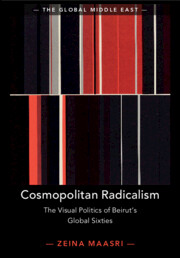Book contents
- Cosmopolitan Radicalism
- The Global Middle East
- Cosmopolitan Radicalism
- Copyright page
- Dedication
- Contents
- Plates
- Figures
- Preface and Acknowledgements
- Note on Transliteration and Translation
- Introduction
- 1 Dislocating the Nation
- 2 The Hot Third World in the Cultural Cold War
- 3 The Visual Economy of ‘Precious Books’
- 4 Ornament Is No Crime
- 5 Art Is in the ‘Arab Street’
- 6 Draw Me a Gun
- Conclusion
- Bibliography
- Index
- Plate Section
3 - The Visual Economy of ‘Precious Books’
Publishing, Modern Art and the Design of Arabic Books
Published online by Cambridge University Press: 20 July 2020
- Cosmopolitan Radicalism
- The Global Middle East
- Cosmopolitan Radicalism
- Copyright page
- Dedication
- Contents
- Plates
- Figures
- Preface and Acknowledgements
- Note on Transliteration and Translation
- Introduction
- 1 Dislocating the Nation
- 2 The Hot Third World in the Cultural Cold War
- 3 The Visual Economy of ‘Precious Books’
- 4 Ornament Is No Crime
- 5 Art Is in the ‘Arab Street’
- 6 Draw Me a Gun
- Conclusion
- Bibliography
- Index
- Plate Section
Summary
Chapter 3 is focused on the short-lived Silsilat al-Nafaʾis (Precious Books Series), published in Beirut by Dar an-Nahar between 1967 and 1971 under the direction of modernist poet Youssuf al-Khal. The series engaged prominent modern Arab artists such as Chafic Abboud, Paul Guiragossian, and Dia al-Azzawi and extended the vision of al-Khal’s journal Shiʿr to the ‘preciousness’ of art books. This publishing endeavour formed a node connecting transnational modernist art and literary circuits with book publishing and was thus paradigmatic of new forms of visuality of the Arabic book. The chapter demonstrates how this new materiality was enabled by a network of changes in the visual arts, printing technologies and the political economy of transnational publishing in late 1960s Beirut. Relations between these three fields are analysed through a multifaceted lens, focusing on the book as at once a product of intellectual and artistic practice, a translocal artefact of visual and print culture and a commodity in a capitalist economy of publishing. The analysis probes the political, intellectual and aesthetic modalities of key books from this series and maps the transnational networks of social relations and circuits of modernism that are interwoven in their undertaking.
Keywords
- Type
- Chapter
- Information
- Cosmopolitan RadicalismThe Visual Politics of Beirut's Global Sixties, pp. 101 - 131Publisher: Cambridge University PressPrint publication year: 2020

